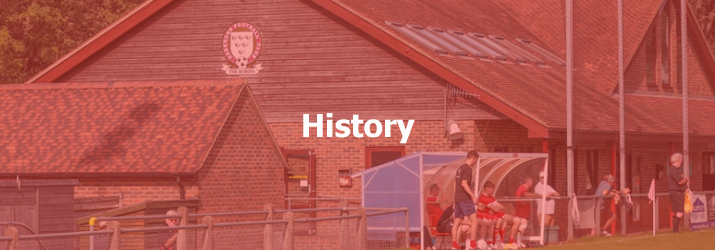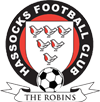
Hassocks Football Club was founded in 1902 and spent the first 80 years of its existence competing in the Mid Sussex Football League and Brighton and Hove and District Football League, playing at Adastra Park in the middle of the village.
The Robins first piece of silverware came when lifting the Mid Sussex League’s prestigious Mowatt Cup in 1928. In 1960, they added the showpiece trophy of the Montgomery Cup to their honours list.
It was a move to the Brighton & Hove League in the mid 1960s that really started to get Hassocks noticed. The Robins won promotion from Division Three to Division One in back-to-back seasons in 1965 and 1966, eventually lifting the Brighton League title in 1972 after finishing runners up the previous year.
The Sussex Intermediate Cup was added in 1975 to complete a golden era for Hassocks. Ambitions of senior football were finally realised for 1981-82 when the club became members of Division One of the Southern Combination Football League.
They finished that first season in 12th place and consolidated their hard earned senior status with a succession of top half placings in the division, until a change in ground grading rules saw them demoted into Division Two and a return to intermediate football.
After several seasons of treading water, 1991 saw huge changes. Former player and manager Jim Goodrum took over as chairman, Dave John arrived as general manager from Haywards Heath Town and a new coaching team of Nick Greenwood and Peter Liddell took over first team affairs with a massive influx of players.
Results were immediate. Greenwood and Liddell led Hassocks to the 1991-92 Division Two title by 10 points in their first season at the helm. More importantly, the progress on the pitch was matched off it with the club finally leaving Adastra Park to move into its own purpose built ground at The Beacon.
The improved facilities which members had spent many years working to secure and build enabled promotion to Division One and a return to senior football.
Just three years later and Greenwood and Liddell took Hassocks into the Premier Division of the Southern Combination League for the first time as runners up in Division One. Having remained in the Premier Division ever since, the Robins are currently the division’s longest serving club.
Floodlights now had to be provided at the Beacon. They came through fundraising and a generous donation from Chelsea vice-chairman and friend of the Robins, Matthew Harding.
Mr Harding lived locally and whose sons Pat and Joel would all go onto represent the club. The floodlights were officially opened when a Chelsea XI featuring Graham Rix and Liam Brady made the journey to the Beacon.
The 1995-96 season saw Hassocks make their debut in the FA Vase. A year later and the Robins entered the FA Cup. Their best run in the world’s greatest cup competition came under the management of John, who led Hassocks all the way to the third qualifying round in 2001-02.
Their adventure was finally ended by Lewes, who themselves enjoyed a memorable year in the FA Cup by advancing to the first round proper and a meeting with Stoke City.
2002 saw Hassocks mark their centenary by facing an ex-Arsenal and Celebrity XI. Later in the year and Steve Coppell took charge of Brighton and Hove Albion for the first time when the Seagulls visited the Beacon to open the new 237-seater Maurice Boxall Stand, funded in part by the previous season’s FA Cup run.
In 2007, the ground was improved further with the opening of a new clubhouse after a long fundraising and building process. The Beacon has regularly held Southern Combination League cup finals ever since, highlighting the excellent facilities at the ground.
The 2011-12 season saw Mickey Jewell lead Hassocks to their highest ever finish of fourth in the Premier Division. A memorable campaign also saw the Robins reach the semi final of the RUR Cup.
Jewell stepped down at the end of the 2013-14 season, replaced by club legend John returning for a brief third spell at the helm alongside his duties as chairman. John was followed by Mark Dalgleish and Phil Wickwar, who produced a great escape from relegation in the second half of the 2014-15 season.
Dalgleish and Wickwar continued to do well under difficult circumstances, defying the odds to avoid the drop despite being one of the only sides in the Premier Division not to pay their players.
The Robins’ proud run of never finishing in the bottom three of the top flight came to an end at the conclusion of the 2017-18 season, although they were spared relegation as only two sides went down.
Wickwar stood down at the end of the campaign, leaving Dalgleish in sole charge for 2018-19. Hassocks were in the Premier Division’s bottom two when Covid-19 brought the 2019-20 season to a premature end, leading to Dalgleish’s departure after a decade at the Beacon.
John was back in charge for the 2020-21 season which again was curtailed due to the pandemic. John moved upstairs to become technical director ahead of the 2021-22 campaign, with Brad Sweetman stepping up to become first team head coach from his role as Under 18s manager.
Sweetman had been part of John’s management team that led the Under 18s to an historic treble in 2017-18, following that up with a succession of runners up finishes when left in sole charge of the Young Robins.
Now, he and the players he had brought through the youth system and into the first team over the past five seasons had the opportunity to prove themselves at senior level.
A difficult first half of the season in which relegation looked a distinct possibility gave way to a much improved second half. Hassocks ended the campaign in 16th spot and reached the semi finals of the RUR Cup for the first time in a decade.
Sweetman was replaced at the end of the season by fan favourite player James Westlake. His rebuilt squad made up of new faces and former favourites lured back to the Beacon finished 10th in 2022-23, securing the club’s first top half placing in nine years.
Better was to come in 2023-24. Hassocks acquired a club-record 78 points to finish fifth in the table, qualifying for the promotion playoffs for the first time. The Robins were eliminated by eventual winners Eastbourne Town.
John retired as chairman at the end of the season, ending over 33 years of day-to-day involvement in running the Robins. The club appointed John president in honour of his service and the Clubhouse bar at the Beacon was renamed the Dave John Lounge.
His final gift was the appointment of his successor. The second-highest goal scorer in Hassocks history, Pat Harding, stepped straight from retirement as a player into the role of chairman, bringing ambitious new ideas to continue the Robins’ progress on and off the pitch.
